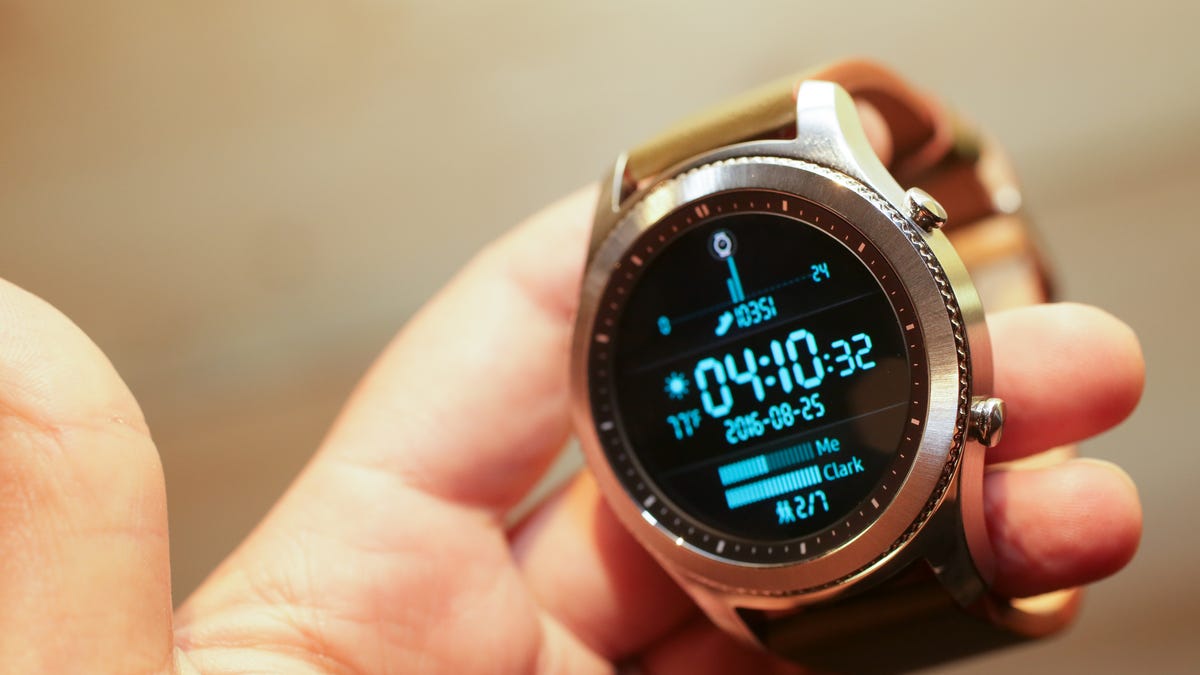For Samsung's Gear S3, size matters. And that's a problem
The latest Samsung smartwatch is even larger than its chunky predecessor. Is the company right to target mostly male early adopters?

Look at Samsung's lineup, and you get the sense that "bigger is better" is a mantra the company takes seriously.
Its greatest contribution to the mobile world, for example, is arguably the proliferation of jumbo phones known as phablets. Next up: a supersized smartwatch.
Samsung on Wednesday unveiled the Gear S3, its latest entry into the burgeoning market of wearable tech. The new smartwatch is more durable and runs longer than its predecessor. It also includes an LTE cellular radio so it doesn't always have to pair with your phone.
The catch is that the S3 also surpasses the previous model in size.
The two versions of the Gear S3, the Frontier and the Classic, both come with the same gain in bulk. Samsung said it needed the extra room to pack in new features. It's also paying attention to trends -- the company said that men are overwhelmingly buying more smartwatches than women, so it felt comfortable with the larger Gear S3. While the exact number varies from region to region, roughly 80 percent of smartwatch buyers are men.
This may, however, be a case where a one-size-fits-all philosophy ends up backfiring. Men may be leading the way in buying smartwatches now, but that may not necessarily be the case in the future. By designing a product that appeals more to men, Samsung could be powering a self-fulfilling prophecy that would trap it in that demographic.
"I don't want to look like a kid playing dress-up with her daddy's watch," CNET editor Jessica Dolcourt said after trying out the Gear S3. "This watch obviously isn't made for my wrist."
The Gear S3 doesn't just exclude women. While larger watches are in vogue now, it takes a certain physique to pull off such a bulky object strapped to your wrist. The watch is 46 millimeters in diameter, up from its previous 43 millimeter body. It seems like a tiny gain, but it makes all the difference. Samsung's latest watch admittedly had me questioning whether I was man enough to wear the Gear S3. Sadly, given my narrow forearms, I'm probably not.
It's not simply a matter of size. Women aren't buying smartwatches because these devices remain the domain of early adopters and gadget enthusiasts, who tend to be male, according to Samsung.
I'm feeling a little insecure about my wrists right now.
Fitness bands have been around longer, which is one reason women gravitate toward them, according to Carolina Milanesi, an analyst at Creative Strategies. There's also a more universal understanding of health benefits of a fitness band, as well as slimmer design. Samsung makes this argument as well, but Milanesi said there is the risk of oversimplification.
"By positioning smartwatches as being 'just for men,' vendors might convince women this category has nothing to offer, leaving them to be content with more and more affordable fitness bands," Milanesi said in a blog post.
The Gear S3 can use Samsung Pay to make purchases at the register.
Samsung's alternatives
For those who prefer a more svelte look, Samsung product manager David Ng pointed to the Gear S2 watch. Women looking for a fitness band should consider its Gear Fit 2, he said.
Although Samsung said it couldn't get all of its new tech to fit into a smaller device, both Motorola and Apple have chosen to come out with two tiers of watches, catering to people with varying wrist sizes.
To be fair, neither Apple nor Motorola offer one with a cellular radio. And with the Gear S2, Gear S3 and Gear Fit 2, Samsung can offer different options to target varying tastes. Apple and Motorola just have their smartwatches.
Samsung "most likely has insight on gender trends between [the smartwatch and fitness tracker]," said Ramon Llamas, an analyst at IDC. "This could be a sign of Samsung playing to how its target segments seem to be trending out between the two devices."
Still, the choice between two sizes has helped the Apple Watch appeal to a wider base of consumers. Apple leads the market for smartwatches even though Samsung has been in the business for twice as long. Motorola, a unit of Lenovo, is the third-largest player behind Samsung, according to IDC.
Anecdotally, I've seen an equal number of men and women sporting an Apple Watch. I've only ever seen men with a Samsung watch.
Milanesi noted that gadget size isn't always an issue for women. (She prefers a larger watch.) But for many women, there just aren't enough features to justify the purchase of a smartwatch, especially given the high price. Samsung hasn't said how much the Gear S3 will cost, but the Gear S2 starts at $299.
"Give women a reason to buy a watch, and they will," Milanesi said.

